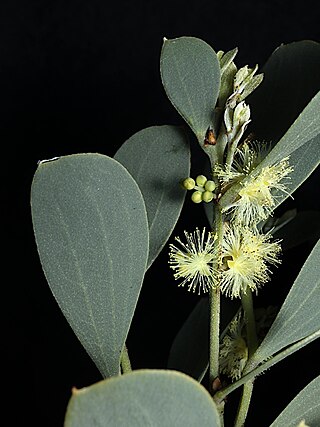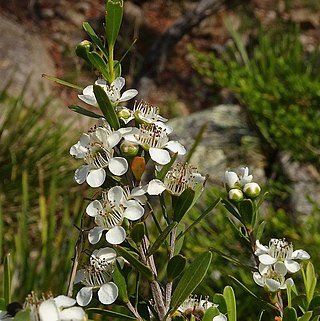
Agonis flexuosa, commonly known as peppermint, is a species of flowering plant in the family Myrtaceae and is endemic to the southwest of Western Australia. The Noongar peoples know the tree as wanil, wonnow, wonong or wannang. It is a tree or shrub with pendulous, very narrowly elliptic, narrowly elliptic or narrowly egg-shaped leaves, white flowers with 20 to 25 stamens opposite the sepals and broadly top-shaped to broadly cup-shaped capsules.

Acacia alpina, commonly known as alpine wattle is a species of flowering plant in the family Fabaceae and is endemic to alpine and subalpine regions of south-eastern continental Australia. It is an erect or spreading shrub or tree with egg-shaped or broadly egg-shaped phyllodes with the narrower end towards the base, flowers arranged in 1 or 2 racemes in the axils of phyllodes, each with cylindrical to oblong, usually pale yellow flowers, and thin-walled, gently curved or coiled pods 30–80 mm (1.2–3.1 in) long.

Acacia longifolia is a species of Acacia native to southeastern Australia, from the extreme southeast of Queensland, eastern New South Wales, eastern and southern Victoria, southeastern South Australia, and Tasmania. Common names for it include long-leaved wattle, acacia trinervis, aroma doble, golden wattle, coast wattle, sallow wattle and Sydney golden wattle. It is not listed as being a threatened species, and is considered invasive in Portugal, New Zealand and South Africa. In the southern region of Western Australia, it has become naturalised and has been classed as a weed due to its out-competing indigenous species. It is a tree that grows very quickly, reaching 7–10 m in five to six years.

Acacia paradoxa is a plant in the family Fabaceae. Its common names include kangaroo acacia, kangaroo thorn, prickly wattle, hedge wattle and paradox acacia.

Acacia verticillata is a perennial shrub to small tree native to south eastern Australia.

Acacia myrtifolia, known colloquially as myrtle wattle, red stem wattle or red-stemmed wattle, is a species of Acacia native to coastal areas of southern and eastern Australia.

Eucalyptus longifolia, commonly known as woollybutt, is a species of medium-sized tree that is endemic to eastern Australia. It has thick, fibrous bark on the trunk and larger branches, lance-shaped to curved adult leaves, flower buds in groups of three, white flowers and cup-shaped to cylindrical or hemispherical fruit. The drooping flower heads in groups of three are a distinguishing feature. It grows in heavy soils often near water.

Acacia brownii, commonly known as heath wattle, is an erect or spreading shrub which is endemic to eastern Australia.

Melaleuca rugulosa, commonly known as scarlet bottlebrush, is a plant in the myrtle family, Myrtaceae and is endemic to South Australia and Victoria in Australia. It is a shrub with an open straggly habit, stiff, sharply pointed leaves and bright red bottlebrush flowers tipped with yellow in summer.

Acacia acuaria is a species of flowering plant in the family Fabaceae and is endemic to the south-western of Western Australia. It is a rounded or diffuse to spreading, prickly shrub with sharply pointed, rigid, needle-shaped phyllodes, flowers arranged in more or less spherical heads of 14 to 23 flowers, and strongly curved or openly coiled pods up to 50 mm (2.0 in) long.

Acacia anceps, commonly known as Port Lincoln wattle or the two edged wattle, is a species of flowering plant in the family Fabaceae and is endemic to coastal areas of south-western Australia. It is a bushy, spreading shrub with glabrous branchlets angled at the ends, elliptic to lance-shaped phyllodes with the narrower end towards the base, spherical heads of 50 to 130 golden-yellow flowers, and narrowly oblong pods up to 60 mm (2.4 in) long.

Acacia baxteri, commonly known as Baxter's wattle, is a shrub belonging to the genus Acacia and the subgenus Phyllodineae, and is endemic to the south west of Western Australia.

Acacia huegelii is a shrub belonging to the genus Acacia and the subgenus Phyllodineae native to Western Australia.

Acacia atrox, commonly known as Myall Creek wattle, is a species of flowering plant in the family Fabaceae and is endemic to a small area in New South Wales. It is a dense, small shrub or tree that often forms suckers with sharply-pointed, more or less rigid, terete phyllodes, cream-coloured to pale yellow flowers arranged in a spherical head of 17 to 41 in axils.

Acacia asparagoides is a species of flowering plant in the family Fabaceae and is endemic to a restricted area of south-eastern New South Wales. It is an erect or spreading shrub with sharply-pointed, more or less rigid, linear phyllodes, bright yellow flowers arranged in a spherical head of 15 to 30 in axils, and narrowly oblong and curved pods up to 40 mm (1.6 in) long.

Acacia siculiformis, commonly known as dagger wattle, is a shrub belonging to the genus Acacia and the subgenus Phyllodineae native to south eastern Australia.

Acacia axillaris, commonly known as midlands mimosa or midlands wattle, is a shrub belonging to the genus Acacia and the subgenus Juliflorae that is native to Tasmania. The species was list as vulnerable in 2014.

Leptospermum emarginatum, commonly known as the twin-flower tea-tree or twin flower teatree, is a species of shrub that is endemic to south-eastern Australia. It has rough bark on the older stems, lance-shaped leaves with the narrower end towards the base and a small notch at the tip, white flowers in groups of up to five and hemispherical fruit that falls off when mature.

Pomaderris phylicifolia, commonly known as narrow-leaf pomaderris, is a species of flowering plant in the family Rhamnaceae and is to south-eastern Australia and New Zealand. It is a slender shrub with hairy stems, narrowly egg-shaped to linear leaves, and small clusters of cream-coloured to yellow flowers.
Marianthus coeruleopunctatus, commonly known as blue-spotted marianthus, is a species of flowering plant in the family Pittosporaceae and is endemic to the southwest of Western Australia. It is a twining shrub or climber with narrowly elliptic leaves and pale blue flowers sometimes with dark blue spots or lines, arranged in branched clusters.




















